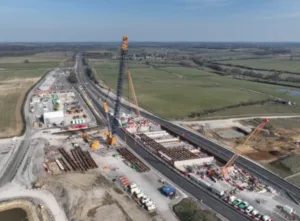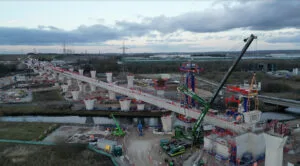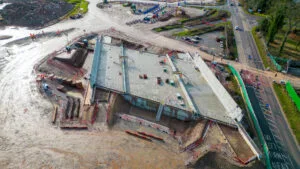HS2 engineers have completed the final operation to move two railway viaducts into place over the M42/M6 link roads in North Warwickshire, making them the first viaduct structures to be built at Delta Junction.
The ‘push’ to move the 158-metre-long ‘West Link Viaduct’ into its final position over both westbound and eastbound motorway link roads took a total of 11 hours over the weekend.
HS2 Ltd, its main works contractor Balfour Beatty VINCI (BBV) and National Highways collaborated to minimise disruption for people using the roads and enabling these engineering feats to take place. Last weekend’s operation was completed quicker than planned, allowing the motorway link roads to be reopened 6.5 hours ahead of schedule.
The viaducts are part of a group of 13 viaducts which make up HS2’s triangular Delta Junction. This section of the railway enables high speed trains to travel between London, Interchange Station in Solihull and Birmingham Curzon Street Station.
In June, the first 84 metre section of the composite viaduct was moved to its halfway position. Since then, three further steel girders were welded to the back of the first section and 38 precast concrete slabs were installed to complete the 158-metre-long structure, which has now been moved over both link roads.
The parallel ‘East Link Viaduct’ was moved into place using an identical two-stage process during two weekend operations in February and April this year. This viaduct is currently being prepared to be brought into use as an internal haul road by the end of December, to move material from Bromford Tunnel to the Delta Junction, taking thousands of lorries off the local road network.
The four operations were delivered by a team of 25 people from specialist steelwork company Victor Buyck Steel Construction (VBSC), working on behalf of BBV, using a push-pull jacking system which gives greater flexibility during the launch operation.
HS2’s high-speed trains will operate on reliable new infrastructure between London and Birmingham, significantly reducing journey times and freeing up space on the existing mainline for more local and freight services. The railway is expected to be operational between 2029 and 2033.




























